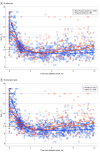Disparities in Hemoglobin A1c Levels in the First Year After Diagnosis Among Youths With Type 1 Diabetes Offered Continuous Glucose Monitoring
- PMID: 37074715
- PMCID: PMC10116368
- DOI: 10.1001/jamanetworkopen.2023.8881
Disparities in Hemoglobin A1c Levels in the First Year After Diagnosis Among Youths With Type 1 Diabetes Offered Continuous Glucose Monitoring
Abstract
Importance: Continuous glucose monitoring (CGM) is associated with improvements in hemoglobin A1c (HbA1c) in youths with type 1 diabetes (T1D); however, youths from minoritized racial and ethnic groups and those with public insurance face greater barriers to CGM access. Early initiation of and access to CGM may reduce disparities in CGM uptake and improve diabetes outcomes.
Objective: To determine whether HbA1c decreases differed by ethnicity and insurance status among a cohort of youths newly diagnosed with T1D and provided CGM.
Design, setting, and participants: This cohort study used data from the Teamwork, Targets, Technology, and Tight Control (4T) study, a clinical research program that aims to initiate CGM within 1 month of T1D diagnosis. All youths with new-onset T1D diagnosed between July 25, 2018, and June 15, 2020, at Stanford Children's Hospital, a single-site, freestanding children's hospital in California, were approached to enroll in the Pilot-4T study and were followed for 12 months. Data analysis was performed and completed on June 3, 2022.
Exposures: All eligible participants were offered CGM within 1 month of diabetes diagnosis.
Main outcomes and measures: To assess HbA1c change over the study period, analyses were stratified by ethnicity (Hispanic vs non-Hispanic) or insurance status (public vs private) to compare the Pilot-4T cohort with a historical cohort of 272 youths diagnosed with T1D between June 1, 2014, and December 28, 2016.
Results: The Pilot-4T cohort comprised 135 youths, with a median age of 9.7 years (IQR, 6.8-12.7 years) at diagnosis. There were 71 boys (52.6%) and 64 girls (47.4%). Based on self-report, participants' race was categorized as Asian or Pacific Islander (19 [14.1%]), White (62 [45.9%]), or other race (39 [28.9%]); race was missing or not reported for 15 participants (11.1%). Participants also self-reported their ethnicity as Hispanic (29 [21.5%]) or non-Hispanic (92 [68.1%]). A total of 104 participants (77.0%) had private insurance and 31 (23.0%) had public insurance. Compared with the historical cohort, similar reductions in HbA1c at 6, 9, and 12 months postdiagnosis were observed for Hispanic individuals (estimated difference, -0.26% [95% CI, -1.05% to 0.43%], -0.60% [-1.46% to 0.21%], and -0.15% [-1.48% to 0.80%]) and non-Hispanic individuals (estimated difference, -0.27% [95% CI, -0.62% to 0.10%], -0.50% [-0.81% to -0.11%], and -0.47% [-0.91% to 0.06%]) in the Pilot-4T cohort. Similar reductions in HbA1c at 6, 9, and 12 months postdiagnosis were also observed for publicly insured individuals (estimated difference, -0.52% [95% CI, -1.22% to 0.15%], -0.38% [-1.26% to 0.33%], and -0.57% [-2.08% to 0.74%]) and privately insured individuals (estimated difference, -0.34% [95% CI, -0.67% to 0.03%], -0.57% [-0.85% to -0.26%], and -0.43% [-0.85% to 0.01%]) in the Pilot-4T cohort. Hispanic youths in the Pilot-4T cohort had higher HbA1c at 6, 9, and 12 months postdiagnosis than non-Hispanic youths (estimated difference, 0.28% [95% CI, -0.46% to 0.86%], 0.63% [0.02% to 1.20%], and 1.39% [0.37% to 1.96%]), as did publicly insured youths compared with privately insured youths (estimated difference, 0.39% [95% CI, -0.23% to 0.99%], 0.95% [0.28% to 1.45%], and 1.16% [-0.09% to 2.13%]).
Conclusions and relevance: The findings of this cohort study suggest that CGM initiation soon after diagnosis is associated with similar improvements in HbA1c for Hispanic and non-Hispanic youths as well as for publicly and privately insured youths. These results further suggest that equitable access to CGM soon after T1D diagnosis may be a first step to improve HbA1c for all youths but is unlikely to eliminate disparities entirely.
Trial registration: ClinicalTrials.gov Identifier: NCT04336969.
Conflict of interest statement
Figures



References
-
- Laffel LM, Kanapka LG, Beck RW, et al. ; CGM Intervention in Teens and Young Adults with T1D (CITY) Study Group; CDE10 . Effect of continuous glucose monitoring on glycemic control in adolescents and young adults with type 1 diabetes: a randomized clinical trial. JAMA. 2020;323(23):2388-2396. doi:10.1001/jama.2020.6940 - DOI - PMC - PubMed

